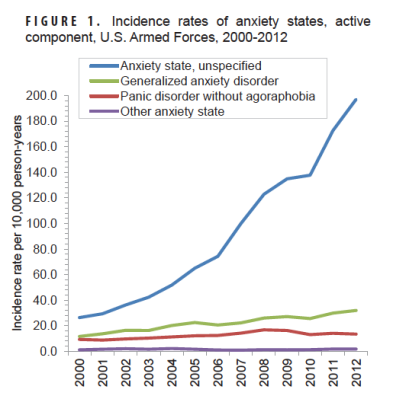After more than a decade of inconclusive wars, accompanied by spikes in post-traumatic stress disorder, traumatic brain injuries and suicides, coming atop deepening defense-budget cuts, it’s no wonder the average GI Joe or GI Jane is feeling more nervous than ever.
On Monday the Pentagon confirmed it: the rate of reported anxiety disorders among U.S. troops jumped 327% between 2000 and 2012.
“In the U.S. Armed Forces, mental disorders, of which anxiety disorders are a subset, account for significant morbidity, disability, healthcare service utilization, lost duty time, and attrition from military service,” the report says. “Of particular concern in this regard, incidence rates of mental disorders overall and anxiety disorders in particular have increased sharply among U.S. military members during the past 10 years.”
The report is the latest in a long line of studies (mental ills, TBIs, alcohol) showing that war’s mental casualties can keep on rising long after most of the shooting has stopped. And these data deal only with troops diagnosed on active duty, not with veterans no longer in uniform.
Military docs diagnosed thousands with problems ranging from generalized anxiety disorder, panic disorders, phobias and obsessive-compulsive disorder. But three of every four had “non-specific anxiety disorders,” the report says, mostly likely rooted in depression or stress “whose symptoms are disruptive or distressing to the affected individual.” PTSD cases, which have been tabulated in earlier reports, were not counted in this one.
“This report tells us two things,” says Elspeth Ritchie, a retired Army colonel who served as the service’s top psychiatrist. “War is not good for mental health, and the psychological consequences of war include more than just PTSD.”
Pentagon health experts combed through medical data seeking anyone on active duty in the Army, Navy, Air Force, Marines and Coast Guard who had sought help for such conditions. “Members of the Army, recruits, enlisted members, and those in healthcare occupations had markedly higher rates of anxiety state diagnoses than their respective military counterparts. Also, females, service members in their twenties, and white, non-Hispanics, had relatively high rates of anxiety state diagnoses,” the study says.
“In addition to increasing rates of diagnoses of anxiety disorders, the overall healthcare burden (e.g., medical encounters, hospital bed days, individuals affected) associated with anxiety disorder evaluation and treatment has also increased dramatically over the past 13 years,” says the report, contained in the October issue of the Pentagon’s Medical Surveillance Monthly Report.
That was the bad news. The good news? “Significant increases in resources to identify and treat mental disorders among service members and successes in reducing stigmatization for seeking care for anxiety symptoms likely contribute to such increases,” it says.


